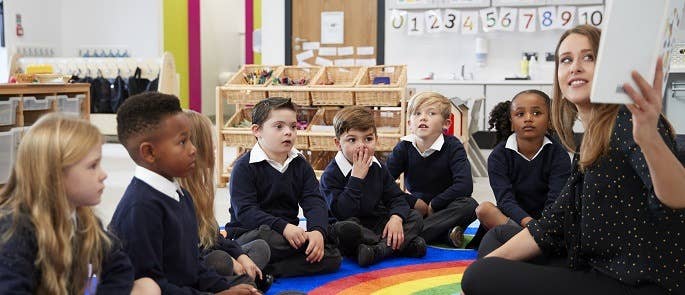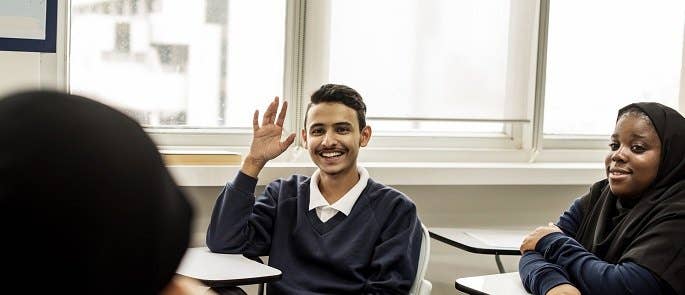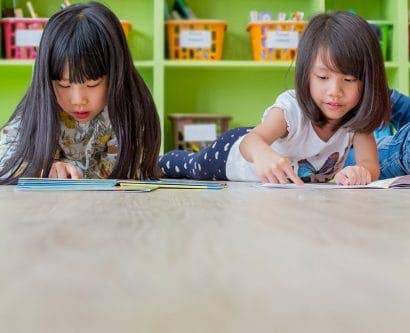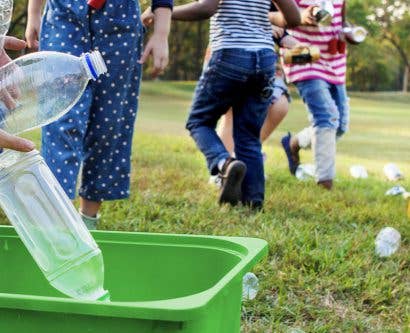How to Create a Positive Learning Environment
A child’s learning environment is the area and culture in which they learn, encompassing their physical, social and emotional surroundings. A positive learning environment can support all children to flourish. Yet without safe and secure surroundings, a child’s ability to learn is severely hindered.
In this article, we will be exploring the question: what is a learning environment? We will highlight the importance of a positive learning environment and we’ll provide you with a range of practical strategies that you can use to improve your teaching and learning space.
‘A teacher must establish a safe and stimulating environment for pupils, rooted in mutual respect.’
Teachers’ Standards, Department for Education

What is a Positive Learning Environment?
A positive learning environment is not a well-backed display with a perfectly trimmed border, nor is it a set of meticulously labelled desk accessories. It’s also not a space created during the summer holidays in preparation for the next academic year.
A learning environment is much more than what you see visually. It consists of three main ingredients – the physical, social and emotional environments. For any high-quality teaching strategy to have an impact, these elements must exist harmoniously.
Imagine the learning environment as the foundations of your teaching and learning. Take them away, and your students’ ability to flourish begins to crumble.
A learning environment is forever ‘under construction.’ It will need to be constantly adapted to suit your students’ needs. Wherever you are in your teaching career, it’s important to take the time to reflect upon the learning environment which your students experience. This reflection will help you to consider which elements need strengthening or altering in order to bolster the teaching and learning provision on offer.
Let’s look at each of the three elements of a learning environment in turn:
Physical Environment
Firstly, schools must create a physical environment that allows all pupils to feel content, comfortable and focused. This means consideration of light, noise, air quality, temperature, reflections and wall colours. For example, where possible, there should be good natural light in classrooms, and quality electrical lighting. Ideally, there should be no glare from direct sunlight, blinds should be effective and the whiteboard projection should be easy to see. An organised and clutter-free space can help students to be more attentive and more engaged with their learning.
‘The physical and social environment in which staff and pupils spend a high proportion of every weekday may have profound effects on their physical, emotional and mental health as well as affecting their attainment.’
Public Health England, The Link Between Pupil Health and Wellbeing and Attainment
Social Environment
Schools must also create an environment that is socially beneficial to learning.
Every school must have an effective, well-established and universally understood whole-school approach to behaviour, to ensure solutions exist which aim to eliminate poor behaviour. Any behaviour that detracts from the academic and social success of the school community, or weakens the self-esteem of staff or students, must be addressed effectively and efficiently if schools wish to nurture an environment conducive to learning.
In an independent 2017 report for the Department for Education, Tom Bennett states that schools can optimise behaviour by:
- Employing committed, highly visible school leaders with ambitious goals.
- Communicating realistic, detailed expectations which are understood clearly by all.
- Having a clear understanding of what the school culture is.
- Ensuring high levels of staff and parental commitment to the school vision and strategies.
- Maintaining high levels of support between leadership and staff.
- Thoroughly executing the school’s policies and strategies.
- Having high expectations of all pupils and staff, and a belief that all pupils matter equally.
Emotional Environment
Children must also feel emotionally prepared to learn. As well as pupils acknowledging that they need to learn in order to reach a certain academic standard, we also want students to show an inherent, independent love of learning – where they learn to enjoy and appreciate each and every step they take in their learning journey.
Motivation in the classroom can help children to become resilient, independent learners, who can manage any challenges they may face in the classroom. Schools can embed whole-school strategies and policies which inspire students intrinsically and extrinsically. Both of these motivators can support each other, and you’ll need to personalise your approach to meet the needs of your pupils. You can find out more about motivation in the classroom here.

Why is a Positive Learning Environment Important?
A positive and purposeful learning environment can boost enjoyment and engagement. It can also help to enrich teaching and learning and improve academic performance. Therefore, it’s essential that schools strive to ensure that they are providing their students with the best possible learning environment.
Effective learning environments promote a strong sense of community, leaving children feeling valued, respected and connected. Building and maintaining working relationships with peers and staff can also contribute to a child’s sense of belonging and provide them with access to important role models. We know that this can help to improve mental health outcomes. For children whose home lives are unpredictable or unstable, a secure, welcoming learning environment in school can help to provide assurance and certainty.
CPD for Education Professionals
With a range of compliance and CPD courses available, find the training you need with High Speed Training. Browse our course library, which includes training such as Challenging Behaviour and Child Mental Health.

Characteristics of a Positive Classroom Environment
Whatever space you are operating in, there are some key changes that you can make to ensure the learning environment is as positive and purposeful as possible.
Be welcoming
Create a strong sense of togetherness and unity within your class or classes. Start by greeting students as they enter your teaching space. Acknowledge those students who are demonstrating elements of your teaching and learning policy. Your positive affirmation might be exactly what a child needs to hear.
Building strong teacher-pupil relationships based on mutual understanding allows you to gain the respect of your classes, as well as demonstrate key social skills. We know that positive relationships in the classroom are critical in encouraging good behaviour and promoting pupil wellbeing.
At the start of the year, agree a set of classroom rules. If you have pastoral responsibilities, aim to create a board or display to reflect the values you all believe in. For example, trust, team work and kindness. Children could present this in a written form or pictorially. Sharing these on social media or through parent/carer learning boards further reinforces the value your school places on community. The board will also act as a daily reminder of the school’s expectations.
To build positivity in the room, start lessons by thanking students for their attention and sharing your excitement for the day or lesson. Similarly, remember to end lessons on a positive note whenever possible.
Finally, reinforce and model social skills. For example, ask students to use their classmates’ names when addressing them and highlight the importance of please and thank you.
Ask the students
Speak to the students to find out what a positive environment looks like to them. This should encompass their physical, social and emotional environments. Consider creating a working party or sending out surveys in order to involve as much student voice as possible.
For example, in considering their physical learning environment, would they find a new colour scheme more conducive to learning? Would they like to design their own reflection space – an area designated to silence, thought and rest? Perhaps consider launching a young designers’ competition whenever you are repurposing spaces in school.
Personalise
Remember that the learning environment you create for your students will need to be adapted to suit individual children’s needs. Students with communication support needs and/or special educational needs (SEN) may, for example, require adaptations to their immediate environment to support them in accessing the curriculum.
Some children, including those with ADHD, might benefit from a standing desk; others, including autistic pupils, may benefit from a low-arousal, calm and structured environment. Furthermore, some students, including those with dyslexia, may benefit from access to a daily timetable and reminders display. Furthermore, children with social, emotional and mental health (SEMH) needs may benefit from access to self-sooth boxes in their learning environment. Self-soothe boxes are made by the child, and are filled with items which make them feel calm. For example, a photograph, a piece of material, a lavender bag or a seashell. If a child begins to feel overwhelmed, they can then collect their box and spend some time looking at each of the objects they have included.
Being aware of each of your students’ needs, and tracking how these change over time, will help you to make the right accommodations to your teaching and learning space.

Follow routines
From supporting transitions to welcoming new students, there are innumerable benefits of adopting clear routines and practices.
Effective practitioners follow agreed routines and standards. These might include rules for classroom discussion, entering and leaving the room, how to behave in the classroom, how to register and how to listen.
Rules and routines provide students with safety, comfort and familiarity. Once they understand and accept the school’s expected standards, they are free to focus on their learning, as many of the uncertainties they may have felt have been removed.
For routines to become accepted and commonplace, they must be universally understood. Therefore, ensure that all members of the school community know and understand the school’s expectations.
‘When a child feels safe, they’re more likely to engage in the learning, manage their emotions and ask for support when needed.’
Dr. Rina Bajaj, The Anna Freud National Centre for Children and Families
Engage
Provide students with access to an enriching and engaging curriculum. To ensure maximum effectiveness, map the curriculum across the school so that students can make links to and build upon prior learning. This progressive approach to curriculum management will help you to nurture inquisitive and inspired learners.
In order to increase inclusivity and stimulate curiosity, consider a multisensory approach. This is especially important when supporting children with special educational needs (SEN) in the classroom.
Similarly, think carefully about the way you communicate with students, so that your lessons are as impactful as possible. You can find out more about how to communicate effectively in the classroom here.
Let your passion for the subject shine through. Remember, enthusiasm is infectious.
Be flexible
Think about how you can utilise the physical items in your space to best suit learning. Think sofas, lounge beanbags and stools, as well as more flexible table configurations. These can be used during group work to boost creativity and provide children with more autonomy in class discussions. If budgets allow, a selection of computers at the back of your classroom can also provide children with more freedom in the way in which they digest and present their learning.

Build resilience
Teachers should create a culture of experimentation. Children need to realise that making mistakes is an essential part of learning. Reworking and revising allows students to cement their understanding. If a student tells you they ‘can’t’ do something, correct them by stating, ‘you can’t do it yet.’ This growth mindset approach is especially important in primary settings, so that young people feel more prepared for any challenges they may face in secondary school. This positive reinforcement also continually reminds your students that you care about each of them individually and that you’re committed to their success.
Reward
Consider all of your learners on a continuum and embrace neurodiversity. Your students will come to you with differing needs, experiences, targets and levels of ability. Whether they’ve made a small step or a giant leap, they deserve to feel proud of themselves.
Remember, rewards don’t have to be material. Simply telling a student exactly what they did well and praising them for it can be enough.
Alongside reward, ensure you have clear strategies for dealing with challenging behaviour. You can find advice on how to set behaviour expectations here.
Reach out for help
Investigate what funding your school may be entitled to. It may be that you can apply to the Local Authority for a particular grant. For example, if you want to create a reflection space to support your students’ mental health or a greenhouse project to develop social enterprise opportunities, you may be able to put a bid together.
Similarly, if you’re planning the upheaval of a key learning environment, you could reach out to members of the community for support. Ex-students studying at nearby schools or colleges could work together to repurpose an old storage room into a cosy space for interventions and coaching sessions, for example. Ask parents and carers to donate old materials or supply artwork for the walls.

Be positive
According to Hughes and Vass (2001), there are three types of language that can be used to support learning and motivation.
Firstly, the language of success. Display your belief and confidence in the students’ abilities through phrases such as, ‘I know you can …’. Next, the language of hope. Encourage the pupils in your class to have a go, even if they are apprehensive by using phrases such as, ‘I’ll try but I need some help …’. Finally, the language of possibility. When your students tell you that they’re ‘not good at X’, introduce a climate of possibility within your response. For example, ‘Yes, I understand that you’re getting a little bit mixed up, but let’s see which element you’re struggling with.’
Consider having a board in your room to highlight the importance of mindset, featuring examples of negative statements alongside their more positive counterparts.
Give freedom
Limited involvement in decision making may cause some students to disengage with school life. Aim to provide children with autonomy and choice. Give them a ‘stake’ in their school community.
This could be at a classroom level, where every child on the table knows their individual role during group tasks and discussions, or at a whole-school level – by promoting responsibilities such as school councillors, assembly technicians and green leaders.
The physical, social and emotional environment in which a child learns can have a profound impact on both their attainment and wellbeing. Therefore, it is essential that schools strive to create positive learning environments. In doing so, they are helping each and every one of their students to flourish.
Further Resources:
- CPD Courses for Teaching and Education
- Understanding the Importance of Motivation in Education
- Safeguarding Children Legislation: Guidance for Schools
- What is Effective Questioning & Why Should I Use it in My Classroom?
- What is Inclusive Practice?
- Educational Bias: How to Avoid Bias in the Classroom
- Conflict in the Classroom: Coaching Children in Acting Responsibly
- What is Effective Teaching?
- What is Adaptive Teaching?
- Metacognition in the Classroom: Benefits & Strategies
- How to Create an Effective Culture of Safeguarding in Schools
- How to Promote Equality, Diversity & Inclusion in the Classroom
- How to Support EAL Students in the Classroom
- Recognising the Signs of Dyslexia in Children
- How to Promote a Reading Culture in Schools
- How to Use Assessment for Learning in Schools
- What is Restorative Practice in Schools & Social Work?
- What are the Emotional Needs of a Child?
- Environmental Awareness For Children: Ideas for Teachers
- Sensory Needs in the Classroom
- What is Ability Grouping in Education?
- How to Teach with Confidence
- What is Mixed Ability Grouping in Education











